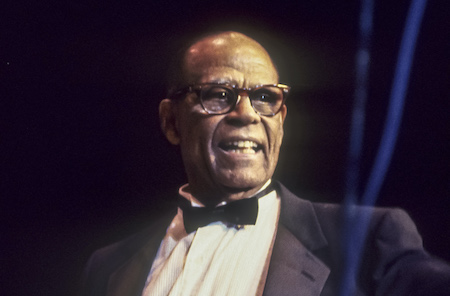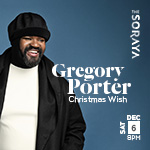Oct 28, 2025 10:47 AM
In Memoriam: Jack DeJohnette, 1942–2025
Jack DeJohnette, a bold and resourceful drummer and NEA Jazz Master who forged a unique vocabulary on the kit over his…

“I wanted to be like Louis Armstrong,” Bauzá once told DownBeat. “I knew all his solos.”
(Photo: Jack Vartoogian)Mario Bauzá (1911–’93) spent much of his distinguished seven-decade career behind the scenes.
Standard jazz histories commonly cite Havana-born Bauzá — recently inducted into the DownBeat Hall of Fame via the Veterans Committee — for mentoring Dizzy Gillespie in the nuts-and-bolts of Afro-Cuban polyrhythms at the end of the 1930s, when both played trumpet (and roomed together) with the Cab Calloway Orchestra. Their connection famously prepared Gillespie for future explorations in blending jazz with Cuban and other Afro-descended, pan-American flavors, and for introducing Gillespie to master conguero Chano Pozo, who fueled the pathbreaking 1947–’48 big band recordings of “Manteca,” “Algo Bueno” and “Cubana Be, Cubana Bop.”
“Living and playing with Mario, I found out that despite the language differences, Afro-Americans and Cubans were not destined to be total strangers, musically,” Gillespie wrote in his memoirs, To Be Or Not To Bop. “In fact, they could sleep in the same bed, at least in the same room.”
By this time, as Gillespie often acknowledged, Bauzá was already combining jazz arranging techniques and unadulterated Afro-Cuban rhythms with Machito and the Afro-Cubans, a racially integrated orchestra fronted by his brother-in-law, vocalist and maraca player Frank “Machito” Grillo. “The band not only modernized Afro-Cuban music, but its name was a wakeup call to the jazz and Latino communities to deal with the West African roots of the complex rhythmic structures — played by conga drum, bongos and timbales — of mambo, cha-cha-cha, son montuno or guaguanco,” said Bobby Sanabria, who played drumset in Bauzá’s orchestra between 1983 and 1993. He notes that Bauzá’s “Tanga,” recorded by the Afro-Cubans in 1943, is the first true Latin jazz hybrid — “the forebear of what was later known as modal harmony, soloing or vamping on one or two chords, which is common in Afro-Caribbean music.”
“[Composer] Chico O’Farrill said it was what he’d always dreamed of: a band with the harmonic sophistication of jazz but also the rhythmic sophistication of his Cuban ancestry,” Sanabria continued. “Without the Machito Orchestra, you don’t have Tito Puente or Tito Rodriguez. You don’t have Arturo O’Farrill’s band. All of us followed them.”
Himself of African descent, Bauzá was raised by his wealthy white Spanish godparents, who started him with solfege at age 4 and gave him a clarinet when he was 7. He studied at Havana Conservatory of Music for the next eight years, declined a scholarship to La Scala in Italy, and instead became one of three clarinetists in the Havana Symphony Orchestra, while concurrently performing in several dance bands. One was led by pianist Antonio Maria Romeu, who brought him to New York in 1927 for a recording date. Already familiar with American jazz via Cuban radio, Bauzá spent his 11-day sojourn frequenting Harlem’s various boîtes, dance halls and variety theaters at night, while spending afternoons hearing midtown performances by Paul Whiteman’s Orchestra, where he admired C-melody saxophonist Frankie Trumbauer’s feature on “Rhapsody In Blue.”
“I fell in love with jazz then,” Bauzá told DownBeat in a 1993 cover story. “I couldn’t stay because I was too young to get a passport.” He returned to Havana, learned the alto saxophone, left the symphony and returned to New York in April 1930 with Orquesta Don Azpiazú, which had recorded “The Peanut Vendor” with Antonio Machin singing and El Chino Lara on trumpet.
Ensconced in Harlem, Bauzá learned English, assiduously networked and gradually established himself as a multiple woodwindist on jobs with, among others, ragtime giant Luckey Roberts and Noble Sissle’s orchestra with Sidney Bechet. In summer 1931, Machin needed a trumpet player to play in the Cuban style on an impending record. Bauzá said, “If you buy me a trumpet, I’ll play.” He was true to his word.
“I fell in love with the trumpet,” Bauzá told DownBeat. “I wanted to be like Louis Armstrong; I knew all his solos.” Two years later, he joined Chick Webb, who told him, “You already have everything you need to play lead trumpet for me … but you pronounce your phrases like a Cuban. I’m going to teach you to pronounce your phrases like an American Negro.” As Bauzá said, “That enabled me to analyze the differences in language between Cuban music and jazz.” The effectiveness of Webb’s ministrations is evident on the anthemic 1934 recording “Stompin’ At The Savoy,” where Bauzá plays the opening muted trumpet solo and, subsequently, a swinging clarinet improvisation. In 1935, Bauzá, now fully bilingual, allegedly brought Ella Fitzgerald to Webb’s attention; in 1936, Webb appointed him the band’s musical director.
Bauzá invited Machito to move to New York in 1937, the year he befriended Gillespie, who impressed him as “the greatest thing I had ever heard.” Bauzá left Chick Webb in 1938, and joined Cab Calloway, whom he persuaded to hire Gillespie. Feeling creatively thwarted, he left in 1940, the year he and Grillo launched Machito and the Afro-Cubans, which he served as music director — introducing several dance crazes, impacting the sounds of jazz and rock ’n’ roll — until 1976.
A well-received 1979 Lincoln Center tribute concert returned Bauzá to public view. He formed his own band (propelled by Sanabria’s drumming), which played frequently throughout the 1980s and was documented on Legendary Mambo King, My Time Is Now and 944 Columbus, all on Messidor, between 1991 and 1993.
Bauzá wasn’t one to look back. Henry Threadgill, who played second alto saxophone and flute in the big band during the latter ’80s, writes in his new memoir: “Bauzá would get impatient with the more conventional players. He’d say, ‘I’ve heard that. Charlie Parker did it all decades ago. Don’t bring that up here.’”
The Mambo King cosigned that sentiment in the aforementioned DownBeat article, published shortly before his death: “Don’t copy the ones who already made it. Those people got there by creating. Everybody wants to be Coltrane; but Coltrane was a creator. Dizzy was Dizzy, and he made it. Try to be yourself. That’s what I tell all the young generation. That’s good advice.” DB

Jack DeJohnette boasted a musical resume that was as long as it was fearsome.
Oct 28, 2025 10:47 AM
Jack DeJohnette, a bold and resourceful drummer and NEA Jazz Master who forged a unique vocabulary on the kit over his…

D’Angelo achieved commercial and critical success experimenting with a fusion of jazz, funk, soul, R&B and hip-hop.
Oct 14, 2025 1:47 PM
D’Angelo, a Grammy-winning R&B and neo-soul singer, guitarist and pianist who exerted a profound influence on 21st…

To see the complete list of nominations for the 2026 Grammy Awards, go to grammy.com.
Nov 11, 2025 12:35 PM
The nominations for the 2026 Grammy Awards are in, with plenty to smile about for the worlds of jazz, blues and beyond.…

Jim McNeely’s singular body of work had a profound and lasting influence on many of today’s top jazz composers in the U.S. and in Europe.
Oct 7, 2025 3:40 PM
Pianist Jim McNeely, one of the most distinguished large ensemble jazz composers of his generation, died Sept. 26 at…

Drummond was cherished by generations of mainstream jazz listeners and bandleaders for his authoritative tonal presence, a defining quality of his style most apparent when he played his instrument unamplified.
Nov 4, 2025 11:39 AM
Ray Drummond, a first-call bassist who appeared on hundreds of albums as a sideman for some of the top names in jazz…






